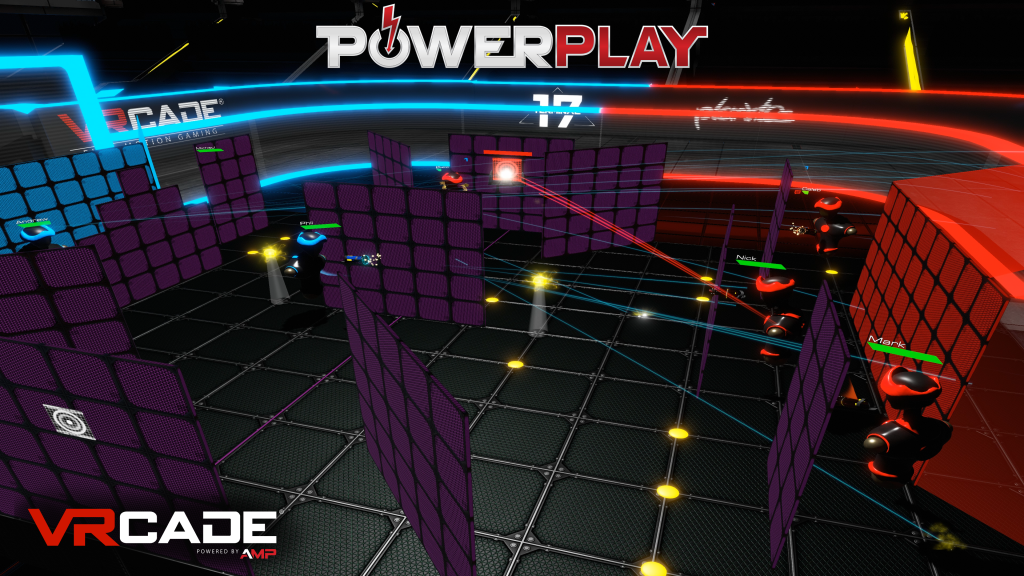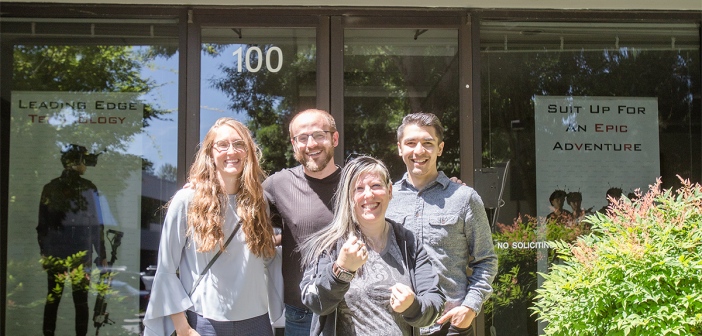VRstudios Makes a PowerPlay
Company Continues to Surprise with Massive D&B Deal, FEC-Focused Management Platform & New Game that Lives Up to the Promise of VR
Thinking of diving in headfirst and adding VR to your location? You may just want to upgrade your air conditioning first, because VRstudios is changing the entrenched concept of gaming as a lazy man’s hobby with its latest developments and content. The Seattle-based studio is swiftly becoming the leader in location-based VR, and for good reason. From penning a wide-ranging deal with Dave & Buster’s to scoring huge IP for current (and upcoming!) games to releasing, in this reporter’s opinion, the only truly athletic, competitive, player vs. player, large-scale VR experience out there, VRstudios seems to have limitless innovation and energy. A quality its fans and players of its games will need sorely for the company’s latest release: PowerPlay.
“We all used to be 300 pounds here at VRstudios!” Chanel Summers, VP of Creative Development at VRstudios, joked. “PowerPlay is honestly an intense, athletic experience. We’ve had a constant stream of demos where players say they finally feel comfortable running in VR. You get swept up in the cinematic experience of the game, so you’re simultaneously engaged both physically and mentally. It’s what everyone wishes eSports were.”
On its surface, the game looks (for lack of a better term) unimpressive. Simplistic graphics, a basic, robot-like avatar, seemingly recognizable gameplay. Those preconceptions are quickly dashed however once the headset goes on and teams are set. Suddenly, instead of standing in a carpeted, camera-lined empty room, you’re in a true arena complete with billboards (hyping other VRstudios’ products) and a ravenous crowd roaring for sport. Two teams of four (or fewer) face-off in this digitized arena, tasked with blasting each other with an arm canon or completing other objectives.
It takes a while to adjust to the new sensations, but after a few minutes of hesitance you soon lose yourself in the experience, forgetting about the lightweight pack on your back, the headphones over your ears and the HMD on your face. For the competitive types, all that matters at that point is winning. The graphics may not be up to AAA caliber, but as many in the arcade industry know, it’s the game that matters, and simple graphics mean a lighter pack and cheaper hardware. After playing for around 20 minutes, I was sweaty, slightly sore and stupendously impressed. Out of all the VR experiences I have tried, PowerPlay is the only one that I would happily play time and time again.

VRstudios’ PowerPlay is a new game for the company’s VRcade Arena and is designed to blend a truly athletic, competitive experience with VR for something the developers feel has immense potential for getting classic on-the-couch gamers out of the house and into game centers.
“Because of the modularity of how we created the game, the competitive matches are dynamically configurable with the multiplayer game modes, battlefield configurations, and arm cannon presets changed to keep things fresh. This is unique to VRcade PowerPlay,” said Summers. “We said in a press release that millions of distinct permutations are available. One of our team members later did the math and it’s actually in the billions.”
But it’s not just the permutations that keep things fresh, it’s the game itself. The company describes it as a mix of laser tag, dodgeball and Pac-Man, all in VR. The most addictive part of PowerPlay is simply the gameplay: By introducing a truly competitive aspect, while simultaneously ensuring that the game runs butter smooth and quickly immerses you, it takes VR up to the level it needs to be to succeed. You’re not just marveling at the world or walking back and forth in a 10’ x 10’ box, but you’re playing an intuitive game full of nuance and reasons to keep playing, while simultaneously realizing it’d be utterly impossible to replicate in real life. PowerPlay augments the technology behind it as much as VR augments PowerPlay, forming a synergistic relationship instead of just betting on the novelty of new technology.
For VRstudios, PowerPlay is just one small aspect of their overarching plan. The company offers a host of supporting products, other games, different sized arenas and more. And it’s all offered with the pinpoint focus of location-based entertainment in mind, instead of many companies simply reskinning home VR games or consumer hardware for use in FECs and beyond.
“Our strategy has always been to focus on the customer market segment,” Vitale continued. “When you look at the type of content we develop, the customer is always in mind, and that customer is the location owner. How will they monetize this best, manage throughput and troubleshoot issues. The way it’s organized is totally based around users in FECs and other locations.”
One way the company has improved their consumer’s experience is through AMP, their Attractions Management Platform. It was created in-house to run all of their attractions, from the smaller VRcade Atom (10′ x 10′) to their flagship VRcade Arena (60′ x 60′). They recently licensed AMP to Dave & Buster’s in a massive deal that looks to get VRstudios content and hardware in D&Bs nationwide.
AMP allows a single employee to manage every detail of a game like PowerPlay, from the map layout to the game mode to customers’ avatars. Additionally, and what any good location should aspire to, it allows for that one employee to become a part of the game, acting like a sportscaster and hyping up both sides, calling out plays and, overall, making the gameplay even more immersive and exciting.
AMP makes the technical aspects easy to handle. It’s up to you to find a creative employee willing to invest their drive into making the experience even more fun for customers. On top of that, AMP allows for easy streaming, locally and online on sites like Twitch. The company believes, as PowerPlay continues to roll out and gain notoriety, it could become a league game with tournaments drawing even more interest.
For now, the company has an impressive library of content with a lot of potential for growth. A game like PowerPlay begs makeovers, reskins, patches and optimization, and according to the company, that is exactly the plan. The game is iterative, and only in its early stages. Time will only make it better as technology continues to improve and the company continues to grow.
VRstudios also has a team-oriented, bug-hunting space game called Terminal 17 that takes players on a 30-minute adventure, as well as a zombie shooter optimized for their smaller arena, the Atom. Summers and Vitale hinted at plenty more to come, as well as some more exciting IP they’ve been entrusted with (another collaboration with Dave & Buster’s). However, they are reluctant to dive into the deep end of IP, and instead focus on creating compelling games that don’t need a flashy brand to sell themselves.
“Big IP won’t make up for a bad experience,” Vitale said. “We are perfecting our experience. I think the industry runs a risk of putting up some artificial barriers in thinking you need big IP in VR to succeed. I don’t think that is true. What you really need is a good game, a great storyline, visual/audio perfection, interactivity and unique mechanics. If you make a really great experience, no one is going to say, ‘Well that was fantastic, but it would have been better if it was branded.’”
That holds true in a game like PowerPlay, which taps into the visceral, simple concepts of gaming that have produced some of the past revelations in the industry. Time will tell whether their venture proves successful, but it’ll be hard for anyone to deny they’ve made a polished, unique, engaging game that could be the start of a massive change to the narrative of VR, and in the end, gaming in general.
Keep up with VRstudios by visiting them online at www.vrstudios.com.




